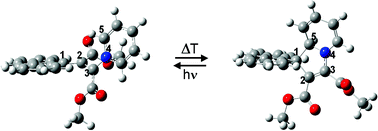Abstract
We have revisited the photochromic spiro-

- This article is part of the themed collection: Photodynamic therapy and photodetection
a
Kansas State University, Department of Chemistry, 111 Willard Hall, Manhattan, KS, USA
E-mail:
sbossman@ksu.edu
Fax: 001-785-532-6666
Tel: 001-785-532-6817
b
Auburn University, Department of Chemistry and Biochemistry, 179 Chemistry Building, Auburn, AL
E-mail:
ortiz@auburn.edu
Fax: 001-614-292-1685
Tel: 001-614-292-6708
c
Ohio State University, Department of Chemistry, 100 W 18 Avenue, Columbus, OH, USA
E-mail:
turro@chemistry.ohio-state.edu
Fax: 001-614-292-1685
Tel: 001-614-292-6708
d
Tribhuvan University, Department of Chemistry, Kathmandu, Kirtipur, Nepal
E-mail:
meghrajpokhrel2000@yahoo.com
e
Department of Organic Chemistry Faculty of Exact and Natural Sciences Tbilisi State University, No.3 Ilia Chavchavadze Ave., Tbilisi 0128, II TSU building, Georgia
E-mail:
eli_go@web.de
We have revisited the photochromic spiro-

 Please wait while we load your content...
Something went wrong. Try again?
Please wait while we load your content...
Something went wrong. Try again?
T. B. Shrestha, J. Melin, Y. Liu, O. Dolgounitcheva, V. G. Zakrzewski, M. R. Pokhrel, E. Gogritchiani, J. V. Ortiz, C. Turró and S. H. Bossmann, Photochem. Photobiol. Sci., 2008, 7, 1449 DOI: 10.1039/B814151G
To request permission to reproduce material from this article, please go to the Copyright Clearance Center request page.
If you are an author contributing to an RSC publication, you do not need to request permission provided correct acknowledgement is given.
If you are the author of this article, you do not need to request permission to reproduce figures and diagrams provided correct acknowledgement is given. If you want to reproduce the whole article in a third-party publication (excluding your thesis/dissertation for which permission is not required) please go to the Copyright Clearance Center request page.
Read more about how to correctly acknowledge RSC content.
 Fetching data from CrossRef.
Fetching data from CrossRef.
This may take some time to load.
Loading related content
